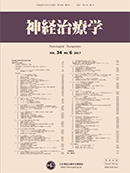Volume 36, Issue 1
Displaying 1-27 of 27 articles from this issue
- |<
- <
- 1
- >
- >|
-
2019Volume 36Issue 1 Pages 1-2
Published: 2019
Released on J-STAGE: July 10, 2019
Download PDF (262K)
-
2019Volume 36Issue 1 Pages 3-5
Published: 2019
Released on J-STAGE: July 10, 2019
Download PDF (279K)
-
2019Volume 36Issue 1 Pages 6
Published: 2019
Released on J-STAGE: July 10, 2019
Download PDF (197K) -
2019Volume 36Issue 1 Pages 7
Published: 2019
Released on J-STAGE: July 10, 2019
Download PDF (262K) -
2019Volume 36Issue 1 Pages 8-9
Published: 2019
Released on J-STAGE: July 10, 2019
Download PDF (292K) -
2019Volume 36Issue 1 Pages 10
Published: 2019
Released on J-STAGE: July 10, 2019
Download PDF (288K) -
2019Volume 36Issue 1 Pages 11
Published: 2019
Released on J-STAGE: July 10, 2019
Download PDF (224K) -
2019Volume 36Issue 1 Pages 12-13
Published: 2019
Released on J-STAGE: July 10, 2019
Download PDF (917K) -
2019Volume 36Issue 1 Pages 14
Published: 2019
Released on J-STAGE: July 10, 2019
Download PDF (224K) -
2019Volume 36Issue 1 Pages 15
Published: 2019
Released on J-STAGE: July 10, 2019
Download PDF (226K) -
2019Volume 36Issue 1 Pages 16-17
Published: 2019
Released on J-STAGE: July 10, 2019
Download PDF (852K) -
2019Volume 36Issue 1 Pages 18-19
Published: 2019
Released on J-STAGE: July 10, 2019
Download PDF (308K) -
2019Volume 36Issue 1 Pages 20
Published: 2019
Released on J-STAGE: July 10, 2019
Download PDF (270K) -
2019Volume 36Issue 1 Pages 21
Published: 2019
Released on J-STAGE: July 10, 2019
Download PDF (264K) -
2019Volume 36Issue 1 Pages 22-23
Published: 2019
Released on J-STAGE: July 10, 2019
Download PDF (308K) -
2019Volume 36Issue 1 Pages 24
Published: 2019
Released on J-STAGE: July 10, 2019
Download PDF (239K) -
2019Volume 36Issue 1 Pages 25
Published: 2019
Released on J-STAGE: July 10, 2019
Download PDF (262K) -
2019Volume 36Issue 1 Pages 26-27
Published: 2019
Released on J-STAGE: July 10, 2019
Download PDF (329K) -
2019Volume 36Issue 1 Pages 28-29
Published: 2019
Released on J-STAGE: July 10, 2019
Download PDF (337K)
-
2019Volume 36Issue 1 Pages 30-34
Published: 2019
Released on J-STAGE: July 10, 2019
Download PDF (868K) -
2019Volume 36Issue 1 Pages 35-39
Published: 2019
Released on J-STAGE: July 10, 2019
Download PDF (644K) -
2019Volume 36Issue 1 Pages 40-43
Published: 2019
Released on J-STAGE: July 10, 2019
Download PDF (399K)
-
2019Volume 36Issue 1 Pages 44-45
Published: 2019
Released on J-STAGE: July 10, 2019
Download PDF (851K) -
2019Volume 36Issue 1 Pages 46-48
Published: 2019
Released on J-STAGE: July 10, 2019
Download PDF (1717K)
-
2019Volume 36Issue 1 Pages 49-52
Published: 2019
Released on J-STAGE: July 10, 2019
Download PDF (359K) -
2019Volume 36Issue 1 Pages 53
Published: 2019
Released on J-STAGE: July 10, 2019
Download PDF (277K) -
2019Volume 36Issue 1 Pages 54
Published: 2019
Released on J-STAGE: July 10, 2019
Download PDF (268K)
- |<
- <
- 1
- >
- >|
